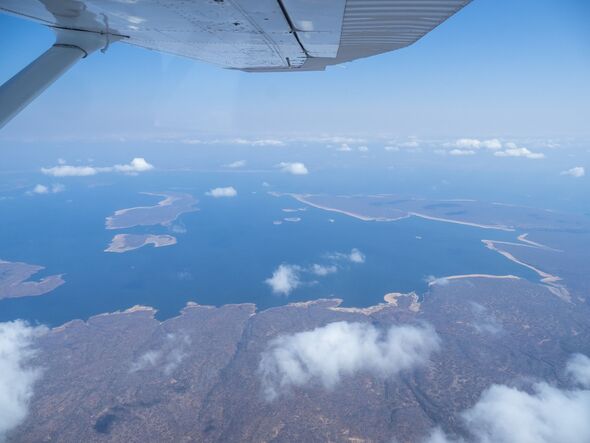Lake Kariba lies between Zambia and Zimbabwe in southern Africa. It was formed following the damming of the Zambezi River in the Kariba Gorge, where the river narrows between hills of hard rock 250 miles below Victoria Falls.
It lies 810 miles upstream from the mouth of the river on the Indian Ocean.
Lake Kariba is over 139 miles long and up to 25 miles wide. It covers an area of 2,150 square miles, and its storage capacity is 44 cubic miles. The mean depth of the lake is 95 feet, with a maximum of 318 feet. As a result, it took five years to fill, between 1958 and 1963.
It is the world’s largest man-made reservoir by volume, four times as large as the Three Gorges Dam in China.
The enormous mass of water is believed to have caused induced seismicity in the seismically active region, with more than 20 earthquakes of a magnitude of five or above on the Richter scale being recorded.
The Zimbabwean town of Kariba was built for construction workers on the lake’s dam. Some settlements, such as Binga village and Mlibizi in Zimbabwe and Siavonga and Singazogwe in Zambia, have expanded to house people displaced by the damming of the river.
Construction of Kariba Dam, a concrete arch dam across the Zambezi, began in November 1956 and was completed in 1959. The structure is 419 feet high, with a crest 1,899 feet in length and a volume of 36.3 cubic feet.
It supplies some 6.7 billion kilowatt-hours of electricity annually, generated by Kariba North Bank and South Bank companies (Zambia and Zimbabwe respectively). Its creation required the resettlement of more than 30,000 Batonka tribespeople of Zambia and the evacuation of thousands of wild animals, known as “Operation Noah”.
While initially an unpopular project, the dam was later accepted because of the inexpensive electric power it provides Zambia’s prosperous copper industry with.
During the filling-up phase, the water was high in nutrients coming from decomposing, inundated vegetation, which created a thick layer of fertile soil on land that became the lake bed. As a result, the lake’s ecology is vibrant, with a number of fish species including the sardine-like kapenta, Nile crocodiles and hippopotamuses.
Fish eagles, cormorants and other water birds line the shores of this lake, as do a large number of elephants and other big game species – including lion, cheetah, leopard and buffalo. The southern Matusadona National Park was once a haven for black and white rhinos, but recent poaching has dramatically reduced their numbers.
Both Zambia and Zimbabwe are now attempting to develop the tourism industry along their respective coasts of the lake.
However, following severe droughts and increased evaporation in the region, the lake’s live storage – the water available for power generation – dropped to just 1.1 metres in early September, according to the Zambezi River Authority (ZRA). This represents 7.7 percent of its usable storage.
As a result, Zambia faced 21-hour power cuts from September 14 when the hydropower plant was set to be turned off, according to African Arguments. This was only the second time the power plant was stopped since its completion, the first occasion in November 2022 on the Zimbabwean side.
The lake’s lowest recorded live storage was reached in December 2022, when it stood just 10 centimetres above its minimum operating level, representing 0.8 percent of usable storage.
The severe droughts were linked to the El Nino weather patterns and extreme weather conditions.
